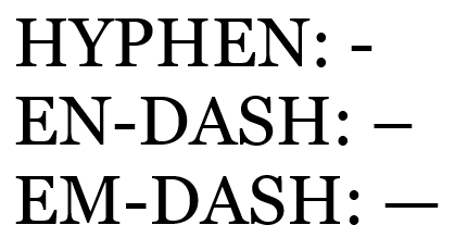- 4-minute read
- 19th August 2014
Hyphens, Dashes and When to Hyphenate
Hyphens and dashes look very similar, so it is easy to mix them up. There are differences between these punctuation marks, though, so it is also important to learn how they should be used.
The Hyphen
The hyphen ( – ) is mostly used to join together two words to form a compound noun, adjective or verb. It should not be confused with dashes, which are longer and used in different contexts. The hyphen is most commonly used in compound modifiers that appear before the term being modified, like this:
Jonathan was an extremely well–read person.
However, some terms are always hyphenated regardless of where they appear in a sentence, so it’s often worth checking a dictionary if you’re not sure when to use one.
A suspended or hanging hyphen occurs when two hyphenated words are used in succession. In this case, the first hyphen can be left ‘hanging’ without its adjoining word:
I collect seventeenth– and eighteenth–century portraits.
The hyphen is also used in newspapers, magazine articles and some books when the final word of a sentence has been cut short by the edge of the column or page. In such cases, it would be used like this:
The Prime Minister has stated her intention to reform plan-
ning permission laws…
However, this is not usually how you would use hyphens in an academic essay, since typesetting is not an issue.
Em Dashes
Dashes come in two kinds: en dashes (–) and em dashes (—), with their names based on their differing lengths. The main use of em dashes is to set part of a sentence apart from surrounding text, like brackets:
The Etruscans—a largely mysterious civilisation—left behind few archaeological artefacts.
Typically, em dashes are unspaced when used parenthetically.
Find this useful?
Subscribe to our newsletter and get writing tips from our editors straight to your inbox.
En Dashes
The main use of a en dash is to indicate a range of values or a sequence of some kind (e.g. ’24–50 degrees’ or ‘London–Paris’). You can also use an en dash to indicate a connection (e.g. ‘Anglo–American relations’).
In addition, en dashes can be used parenthetically, like the em dashes above. This is more common in the UK than the US, and you would usually add spaces before and after parenthetical en dashes:
The Etruscans – a largely mysterious civilisation – left behind few archaeological artefacts.
Whether to use em dashes or en dashes to set apart part of a sentence is largely a matter of preference. However, if you’re using a style guide, make sure to check for guidelines on dash usage. And whichever style of dash you decide to use, make sure to apply it consistently.
When to Hyphenate
Using a hyphen is known as ‘hyphenation’. Sometimes this occurs simply because it is conventional to hyphenate a word (e.g. ‘part–time’).
Likewise, hyphens are usually added to compound adjectives (i.e. adjectives made up of two or more words) when they appear before the noun they are modifying. The phrase ‘two–week holiday’, for instance.
Words which begin with a prefix (e.g. ‘pre-’, ‘non-’ or ‘re-’) are often hyphenated, too, especially when there is a letter clash. For example, ‘reermerging’ should be written as ‘re–emerging’, because the prefix ‘re-‘ ends with the same letter as ’emerging’.
In some cases, hyphenation can completely change the meaning of a sentence. Take, for example:
- I came across a man eating grizzly bear.
- I came across a man–eating grizzly bear.
The first sentence could describe finding a man eating a grizzly bear. The second (hyphenated) sentence makes it clear that ‘man–eating’ is quality of the bear.
Because of this potential to change the meaning of something, the important thing when using hyphens is clarity. Make sure you also check your style guide for advice on hyphenation, as this can vary between institutions.




